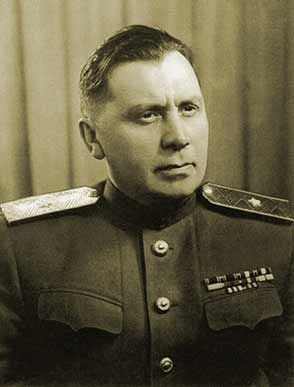Name Nahum Eitingon | ||
 | ||
Died May 3, 1981, Moscow, Russia | ||
Nahum Isaakovich Eitingon, or Naum Isaakovič Ejtingon (Russian: Наум Исаакович Эйтингон, Hebrew: נחום אייטינגון), also known as Leonid Aleksandrovich Eitingon (Russian: Леонид Александрович Эйтингон) (6 December 1899, Shkloŭ, Mogilev Governorate – 3 May 1981, Moscow), was a Soviet intelligence officer, who was sometimes described as a major organizer of Joseph Stalin's state terrorism system. He is the brother of Max Eitingon.
Contents
Career
Eitingon, a Belarusian Jew, joined the Cheka in 1920, shortly before his 21st birthday. Along with other Chekists, he took part in numerous operations during the Russian civil war, including the "liquidation" of a number of the more prosperous citizens of the Belarusian town of Gomel. At the end of the 1920s, Eitingon, a polyglot, organized and led an operation producing fake documents which persuaded the Japanese that 20 Russian agents who were working for them had secretly applied to have their Soviet citizenship restored. This ruse resulted in the Japanese executing their anti-Soviet allies.
He was recruited by INO (Soviet foreign intelligence) chief Artur Artuzov to lead the "illegals" program in April 1933.
He was active in Spain in the late 1930s, during the Spanish Civil War and in Belarus during the Second World War. As a high-ranking NKVD officer, Eitingon was responsible for numerous kidnappings and assassinations, even in peacetime.
During the 1930s, Eitingon established an illegal espionage network in the United States among Jews who had left Russia shortly before the Russian Revolution broke out. This penetration of Soviet intelligence into the United States helped the Soviets to gain, later on, a foothold in the scientific community. During the early 1940s, Eitingon had as many as 40 Soviet agents among the scientists and personnel who were working on the Manhattan Project at or near Los Alamos, New Mexico, and Berkeley, California.
Assassination of Trotsky
Leon Trotsky, the Soviet revolutionary, had been banished from the USSR by Joseph Stalin and had found refuge in Mexico. Stalin assigned the organisation and execution of a plan to assassinate Trotsky to Eitingon. Eitingon, while in Spain during the Spanish Civil War, was able to recruit the services of a young Spaniard communist ideologue, Ramón Mercader, to act as executioner. Trotsky was living in Mexico at the time and, soon after Mercader worked his way into Trotsky's group of friends, Eitingon, too, arrived in Mexico.
On August 20, 1940, Mercader attacked and fatally wounded Trotsky with an ice axe while the exiled Russian was in the study of his house in Coyoacán (then a village on the southern fringes of Mexico City). Eitingon and another collaborator (Caridad Mercader, Ramon Mercader's mother) in the assassination plot were waiting outside Trotsky's residence, in separate cars, to provide a getaway for Mercader. When Mercader failed to return (having been detained by Trotsky's bodyguards), they both left and fled the country.
Doctors' Plot
In October 1951, Major-General of State Security Eitingon, along with three other high-ranking members of the government (all Russian Jewish), were accused of "a Zionist plot to seize power" (the Doctors' Plot). Eitingon's sister Sofia was also arrested. As a doctor, she was considered to be the "link" to the plotting doctors who were allegedly planning to poison high-ranking Soviet leaders. The officers were all imprisoned in cold, dark cells and tortured. The tortures led many of them to falsely confess but Eitingon was steadfast in his denial. Sofia was sentenced to 10 years in prison.
After Stalin's death in March 1953, the head of Soviet intelligence and security services Lavrentiy Beria issued an order to close the cases against the "Zionist plotters" and all were released, including Sofia.
Beria was arrested in June 1953 and executed. Eitingon, considered a supporter of Beria, was arrested again and held in jail without trial at the Butyrka prison in Moscow for four years. In November 1957 he was put on trial, in which he was accused (again) of conspiracy against the regime. The court sentenced him to 12 years in prison, his rank and all his medals were taken from him. After Nikita Khrushchev's ouster from power in 1964, Eitingon was released from prison. After his release he worked as an interpreter.
Nahum Eitingon died in 1981. In 1992 the Russian Supreme Court annulled the conviction and cleared his name. Eitingon had persistently sought his official rehabilitation, but this was granted only posthumously.
